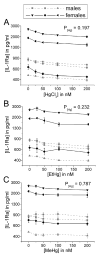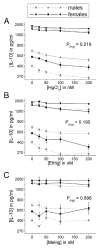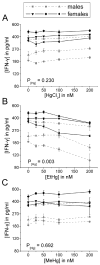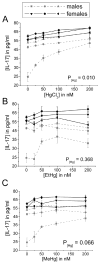Differential immunotoxic effects of inorganic and organic mercury species in vitro
- PMID: 20600710
- PMCID: PMC4160064
- DOI: 10.1016/j.toxlet.2010.06.015
Differential immunotoxic effects of inorganic and organic mercury species in vitro
Abstract
Despite the fact that humans are exposed to multiple forms of mercury (elemental, inorganic, and organic), most research on mercury toxicity has focused on methylmercury (MeHg) and on neurotoxic outcomes and mechanisms. Recent work has indicated that the immunotoxic effects of mercury compounds may be significant contributors to human disease as well as mechanistically relevant to other target organ toxicities. In this study, we compared the effects of inorganic Hg (iHg) to organic Hg species (MeHg and ethylmercury, EtHg) in human peripheral blood mononuclear cells (PBMCs) in vitro at sub-cytotoxic concentrations, using methods developed to characterize response of human PBMCs to iHg in vitro. PBMCs were isolated from six volunteer blood donors (three males and three females) and cultured in the presence and absence of lipopolysaccharide (LPS) and low levels (up to 200nM of each Hg species, separately) for 24h in culture. Cell culture supernatants were analyzed for cytokine concentrations with a bead-based multiplex assay. We report that iHg and MeHg both increase pro-inflammatory cytokine release in LPS-stimulated PBMCs, while EtHg decreases IFN-gamma release as well pro-inflammatory cytokine release. IL-17 release is significantly increased only in response to iHg treatment. Levels of anti-inflammatory cytokines (IL-1Ra and IL-10) were not significantly altered by any Hg treatment. These results indicate that both organic and inorganic species of Hg can affect the human immune system, but that they may exert different effects on immune function.
Copyright 2010 Elsevier Ireland Ltd. All rights reserved.
Conflict of interest statement
The authors declare that there are not conflicts of interest.
Figures









Similar articles
-
Toxicity of organic and inorganic mercury species in differentiated human neurons and human astrocytes.J Trace Elem Med Biol. 2015 Oct;32:200-8. doi: 10.1016/j.jtemb.2015.06.008. Epub 2015 Jul 15. J Trace Elem Med Biol. 2015. PMID: 26302930
-
EtHg is more toxic than MeHg to human peripheral blood mononuclear cells: Involvement of apoptotic, mitochondrial, oxidative and proliferative parameters.Biochim Biophys Acta Gen Subj. 2023 Oct;1867(10):130446. doi: 10.1016/j.bbagen.2023.130446. Epub 2023 Aug 22. Biochim Biophys Acta Gen Subj. 2023. PMID: 37619690
-
Toxicity of ethylmercury (and Thimerosal): a comparison with methylmercury.J Appl Toxicol. 2013 Aug;33(8):700-11. doi: 10.1002/jat.2855. Epub 2013 Feb 11. J Appl Toxicol. 2013. PMID: 23401210 Review.
-
Dose and Hg species determine the T-helper cell activation in murine autoimmunity.Toxicology. 2007 Jan 5;229(1-2):23-32. doi: 10.1016/j.tox.2006.09.006. Epub 2006 Sep 24. Toxicology. 2007. PMID: 17084957
-
Neurotoxic effects of combined exposures to aluminum and mercury in early life (infancy).Environ Res. 2020 Sep;188:109734. doi: 10.1016/j.envres.2020.109734. Epub 2020 Jun 8. Environ Res. 2020. PMID: 32544722 Review.
Cited by
-
Associations between mercury exposure and the risk of nonalcoholic fatty liver disease (NAFLD) in US adolescents.Environ Sci Pollut Res Int. 2019 Oct;26(30):31384-31391. doi: 10.1007/s11356-019-06224-5. Epub 2019 Aug 31. Environ Sci Pollut Res Int. 2019. PMID: 31473923
-
Environmental Risk Factors for Systemic Lupus Erythematosus Through the Lens of Social Determinants of Health.Arthritis Care Res (Hoboken). 2025 Jun;77(6):689-699. doi: 10.1002/acr.25497. Epub 2025 Jan 25. Arthritis Care Res (Hoboken). 2025. PMID: 39800912 Review.
-
Protective effect of a novel peptide against methylmercury-induced toxicity in rat primary astrocytes.Neurotoxicology. 2012 Aug;33(4):763-8. doi: 10.1016/j.neuro.2011.12.004. Epub 2011 Dec 14. Neurotoxicology. 2012. PMID: 22186600 Free PMC article.
-
The psychoimmunology of lyme/tick-borne diseases and its association with neuropsychiatric symptoms.Open Neurol J. 2012;6:88-93. doi: 10.2174/1874205X01206010088. Epub 2012 Oct 5. Open Neurol J. 2012. PMID: 23091569 Free PMC article.
-
Association between environmental mercury exposure and allergic disorders in Korean children: Korean National Environmental Health Survey (KoNEHS) cycles 3-4 (2015-2020).Sci Rep. 2024 Jan 17;14(1):1472. doi: 10.1038/s41598-024-51811-3. Sci Rep. 2024. PMID: 38233475 Free PMC article.
References
-
- Alves MF, Fraiji NA, Barbosa AC, De Lima DS, Souza JR, Dorea JG, Cordeiro GW. Fish consumption, mercury exposure and serum antinuclear antibody in Amazonians. Int J Environ Health Res. 2006;16:255–262. - PubMed
-
- Apostolakis S, Vogiatzi K, Krambovitis E, Spandidos DA. IL-1 cytokines in cardiovascular disease: diagnostic, prognostic and therapeutic implications. Cardiovasc Hematol Agents Med Chem. 2008;6:150–158. - PubMed
-
- Arnett FC, Reveille JD, Goldstein R, Pollard KM, Leaird K, Smith EA, Leroy EC, Fritzler MJ. Autoantibodies to fibrillarin in systemic sclerosis (scleroderma). An immunogenetic, serologic, and clinical analysis. Arthritis Rheum. 1996;39:1151–1160. - PubMed
-
- Bach JF. Infections and autoimmune diseases. J Autoimmun. 2005;25(Suppl):74–80. - PubMed
Publication types
MeSH terms
Substances
Grants and funding
LinkOut - more resources
Full Text Sources

